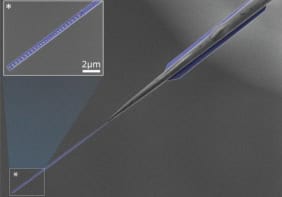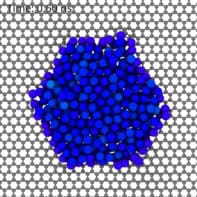
Water’s strange and life-giving qualities could be at least partly explained by quantum mechanics. That is the claim being made by a group of physicists in the UK and the US, who have made extremely sensitive measurements of the protons in tiny samples of water and have found that these protons behave very differently to those in much larger sample.
Water has a host of properties that set it apart from other substances and which make it particularly suited to sustaining life. For example, the fact that it is less dense as a solid than as a liquid and that its maximum density occurs at 4 °C, means that lakes freeze from the top-down rather than the bottom-up – something that was vital to sustaining life during ice ages.
In the latest work, George Reiter of the University of Houston and colleagues study in detail the key to water’s unusual properties – the hydrogen bond. This is the bond between water molecules, connecting the oxygen atom of one molecule to the hydrogen atom in another. Hydrogen bonds are usually considered primarily as an electrostatic phenomena, in other words that water consists of discrete molecules bound to one another through positive and negative charges (residing on the hydrogen and oxygen atoms respectively). This simple picture is able to explain some of water’s features, such as its structure – the predictions of the model agreeing well with the results of neutron-scattering experiments that reveal how far apart on average one oxygen atom is from the next.
Poor proton predictions
What Reiter and team have found, however, is that this electrostatic model cannot be used to predict the energies of individual protons within water molecules. They came to this conclusion after confining water inside 1.6 nm-diameter carbon nanotubes and then exposing these nanotubes to high-energy neutrons from the ISIS neutron source at the Rutherford Appleton Laboratory in the UK. The neutrons’ high energy meant that they bounced off the protons within the water before the deflected protons had a chance to interact with their surroundings, so by recording the energy distribution of the outgoing neutrons the researchers were able to obtain a direct measurement of the momentum distribution and kinetic energy of the protons.
They found that the momentum distribution of the protons was strongly temperature dependent, with as much as 50% more kinetic energy than the electrostatic model predicts at low temperatures and 20% more kinetic energy at room temperature. The electrostatic model gives broadly the correct values for bulk water at room temperature.
The team argues that this is evidence that the protons exist in a previously unobserved quantum state when water is confined to a very tiny volume – a state that is not described by the electrostatic model. They say that whereas at the 0.1 nm distances that typically separate molecules only the intermolecular potential well exerts a significant force, at the 0.01 nm scale typical of an individual proton’s potential well quantum fluctuations in charge that take place along the hydrogen bonds become significant. In this way the hydrogen bonds form what is known as a “connected electronic network” and they speculate that it is the response of the network to confinement that causes the large changes in proton energy.
Seen in other confined spaces
The researchers confirmed this discrepancy using other materials. For example, they found that when water was confined within the industrial material Nafion, a proton-exchange membrane used in fuel cells, the protons had nearly twice the kinetic energy as bulk water. They also found that when using 1.4 nm-diameter single-wall carbon nanotubes, the distribution was 30% less kinetic energy than in bulk water. “There is no chemical reaction taking place here,” says Reiter, “so the only difference between the two sets of nanotubes is their size. That tells me that the quantum state is fitting into the cylinder and that it matters how big the cylinder is.”
According to Reiter, the quantum ground state that they have identified could be important to life because the confinement length typical of their experiments – about 2 nm – is roughly equal to the distances between structures within biological cells. “I think that the quantum mechanics of protons in water has been playing a role in the development of cellular life all along but we never noticed before,” he says.
Reiter also believes that his group’s research could have practical applications, such as improving the performance of fuel cells. He points out that they found a correlation between the conductivity of water when confined in Nafion and the degree to which the protons within the water exist in a double, rather than a single, potential well.
Sow-Hsin Chen of the Massachusetts Institute of Technology, who did not take part in the current research, agrees that the results of the experiment imply that the pattern of hydrogen bonds in confined water may be quite different to that in bulk water, and says that the next step is to carry out quantum mechanical simulations to find out how this affects the properties of confined water. But he cautions that not all of water’s properties are necessarily explainable using quantum mechanics. In particular, he believes that the claim, made by several research groups, that supercooled water has distinct high- and low-density forms, is better explained using statistical mechanics than it is by considering the behaviour of individual particles.
The research is described at arXiv:1101.4994.



